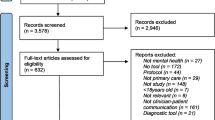Abstract
Objective
To review the literature pertaining to communication patterns and dynamics of doctor-patient-companion or ‘triadic’ medical encounters as identified in both quantitative and qualitative studies. To consider the role of an attending companion in specialist groups using the context of chronic pain as a group example.
Methods
Studies were identified via database searches and reference lists. The eligibility of studies and data extracted were cross-checked with inclusion and exclusion criteria.
Results
Of the 1094 titles identified, 20 studies were included for review. Tables were created for patient settings and study outcomes. Results indicated that companions frequently attended consultations, usually with a relative such as their spouse or adult child and were found to influence communicative processes in the encounter. This influence could either be negative (limiting the exchange of information, particularly relating to sensitive topics) or positive (improvement of self-care management), with study outcomes varying widely. The chronic pain subgroup has not yet been researched in the context of triadic consultations.
Conclusion
Triadic communication can be advantageous in medical encounters; however, as differences exist depending on the individual medical setting, caution should be asserted in generalising findings.
Similar content being viewed by others
References
Roter D (2000) The medical visit context of treatment decision-making and the therapeutic relationship. Health Expect 3:17–25
Callery P, Milnes L (2012) Communication between nurses, children and their parents in asthma review consultations. J Clin Nurs 21:1641–1650
Doherty M, Thompson H (2014) Enhancing person-centred care through the development of a therapeutic relationship. Br J Community Nurs 19:502–507
Zalihic A, Černi Obrdalj E (2014) Fundamental communication skills in medical practice as minor elective subject. Acta Med Acad 43:87–91
Stewart MA (1995) Effective physician-patient communication and health outcomes: a review. CMAJ 152:1423–1433
Adelman RD, Greene MG, Charon R (1987) The physician-elderly patient-companion triad in the medical encounter: the development of a conceptual framework and research agenda. Gerontologist 27(6):729–734
Wolff JL, Roter DL (2011) Family presence in routine medical visits: a meta-analytical review. Soc Sci Med 72:823–831
Laidsaar-Powell RC, Butow PN, Bu S et al (2013) Physician-patient- companion communication and decision-making: a systematic review of triadic medical consultations. Patient Educ Couns 91:3–13
Greene MG, Majerovitz SD, Adelman RD et al (1994) The effects of the presence of a third person on the physician-older patient medical interview. J Am Geriatr Soc 42:413–419
Cene CW, Haymore LB, Lin FC et al (2015) Family member accompaniment to routine medical visits is associated with better self-care in heart failure patients. Chronic Illness 11:21–32
Del Piccolo L, Goss C, Bottacini A et al (2014) Asking questions during breast cancer consultations: does being alone or being accompanied make a difference? Eur J Oncol Nurs 18:299–304
Glasser M, Prohaska T, Gravdal J (2001) Elderly patients and their accompanying caregivers on medical visits. Res Aging 23:326–348
Eggly S, Harper FWK, Penner LA et al (2011) Variation in question asking during cancer clinical interactions: a potential source of disparities in access to information. Patient Educ Couns 82:63–68
Andrades M, Kusar S, Ambreen A (2013) Role and influence of the patient’s companion in family medicine consultations: “the patient’s perspective”. J Fam Med Prim Care 2:283–287
Street RL, Gordon HS (2008) Companion participation in cancer consultations. Psycho- Oncology 17:244–251
Shields CG, Epstein RM, Fiscella K et al (2005) Influence of accompanied encounters on patient-centeredness with older patients. J Am Board Fam Pract 18:344–354
Labrecque MS, Blanchard CG, Ruckdeschel JC et al (1991) The impact of family presence on the physician-cancer patient interaction. Soc Sci Med 33:1253–1261
Ellingson LL (2002) The roles of companions in geriatric patient-interdisciplinary oncology team interactions. J Aging Stud 16:361–382
Eide H, Sibbern T, Egeland T et al (2011) Fibromyalgia patients’ communication of cues and concerns: interaction analysis of pain clinic consultations. Clin J Pain 27:602–610
Kenny DT (2004) Constructions of chronic pain in doctor–patient relationships: bridging the communication chasm. Patient Educ Couns 52:297–305
Flor H, Kerns RD, Turk DC (1987) The role of spouse reinforcement, perceived pain, and activity levels of chronic pain patients. J Psychosom Res 31:251–259
Block AR, Kremer EF, Gaylor M (1980) Behavioral treatment of chronic pain: the spouse as a discriminative cue for pain behavior. Pain 9:243–252
Rpmano JM, Turner JA, Jensen MP et al (1995) Chronic pain patient-spouse behavioral interactions predict patient disability. Pain 63:353–360
Jamison RN, Virts KL (1990) The influence of family support on chronic pain. Behav Res Ther 28:283–287
Eggly S, Penner LA, Hagiwara N et al (2013) Patient, companion, and oncologist agreement regarding information discussed during triadic oncology clinical interactions. Psycho-Oncology 22:637–645
Brown JB, Brett P, Stewart M et al (1998) Roles and influence of people who accompany patients on visits to the doctor. Can Fam Phys 44:1644–1650
Cordella M (2011) A triangle that may work well: Looking through the angles of a three-way exchange in cancer medical encounters. Discourse Commun 5:337–353
Mazer BL, Cameron RA, Deluca JM et al (2014) “Speaking-for” and “speaking-as”: pseudo-surrogacy in physician-patient-companion medical encounters about advanced cancer. Patient Educ Couns 96:36–42
Karnieli-Miller O, Werner P, Neufeld-Kroszynski G, Eidelman S (2012) Are you talking to me?! An exploration of the triadic physician–patient–companion communication within memory clinics encounters. Patient Educ Couns 88:381–390
Author information
Authors and Affiliations
Corresponding author
Ethics declarations
Conflict of interest
The authors declare that they have no conflict of interest.
Ethical approval
All procedures performed were in accordance with the ethical standards of the institutional and/or national research committee and with the 1964 Helsinki declaration and its later amendments or comparable ethical standards.
Informed consent
Informed consent was obtained from all individual participants included in the study.
Rights and permissions
About this article
Cite this article
Troy, E., Doltani, D. & Harmon, D. The role of a companion attending consultations with the patient. A systematic review. Ir J Med Sci 188, 743–750 (2019). https://doi.org/10.1007/s11845-018-1920-0
Received:
Accepted:
Published:
Issue Date:
DOI: https://doi.org/10.1007/s11845-018-1920-0




